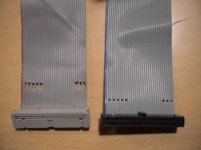I got a 1000SL of my own, thanks to eBay. Now I have to find a NEC V30 chip!

Just like the original 1000, the fan is LOUD, and blows a tremendous amount of air. Maybe that was needed for non-air-conditioned schools in Tandy's home state of Texas, but otherwise it's really overkill.
Mine came with the fully populated 640K RAM on the motherboard, but it steals 64K of that for use as video RAM, so you really end up with 576K. (This is why the RL and TLs came with up to 768K RAM -- the extra 128K was reserved for the video.)
No SmartWatch real-time clock chip, but there's an empty socket for one. (Anybody got a spare?)
Mine also came with a cheap and nasty Taiwanese MFM controller card (DTK?) with the drive types hard-wired into the ROM (not user configurable)... and a (gasp!) Kalok Octagon KL-320 hard drive. It has read errors all over the place, so it may be headed for the trash can, just like every other Kalok drive I've ever encountered or heard of before.
Thankfully, though, that Kalok was intalled with the necessary proprietary mounting rails to use the bottom drive bay. If I didn't have those, it would definitely take some craftsmanship to properly install a drive there!
And speaking of drives, this is just about the worst Tandy to install different floppy drives into. First of all, the provided floppy cable is way too short to use anything other than the original Teac 5.25" drives, which have their Pin 1 on the opposite side of the industry standard. It also doesn't have the twist between the A and B drives, so you have to set Drive A to use Drive Select 0 -- and most modern 3.5" drives don't give you drive select jumpers anymore!
So, you're thinking, just replace the floppy cable with a longer one with the twist, and then all will be good -- but WATCH OUT! The motherboard supplies +5 and +12 volts DC through some of the pins normally used for ground, but the factory supplied extra-short floppy cable has the corresponding wires punched out, breaking the connection to the power and making it safe for use with normal drives. But if you install a different cable and don't also clip out those wires, you'll surely burn out your floppy drives by putting that voltage where it doesn't belong!
The Molex power cables are also too short to reach anything other than the exact location of the power plugs on the OEM Teac drives -- mine already came with a Y-adapter installed, to reach the Kalok hard drive.
Still, it's a good model for playing Tandy games -- the built-in speaker is large and sounds good, and you get a handy volume control knob right on the front panel.

